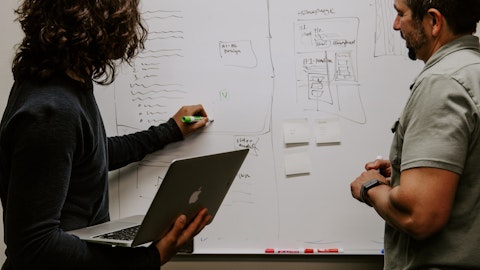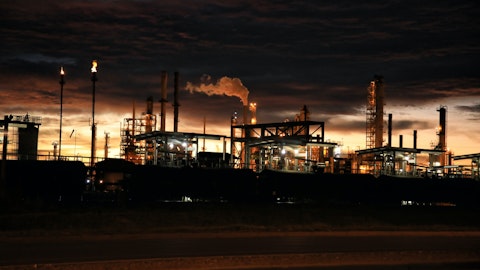Doug Leggate: Someone didn’t pay the phone bill, guys. I’m so sorry about that. So how is everybody doing? Thanks. I apologize for that. So I, well I was half of my questions got asked, but let me give it a go. I guess Mike, first of all, when I look at the earnings part of the business, and I look at where your share price is trading. And obviously you gave us a dividend back in November. How are you thinking about you reloaded the buyback program? How are you thinking about the balance between dividends and share buybacks? And you know where I’m going with this? Because obviously, your dividend is fully covered by your distributions from MPLX. So in this kind of environment, should we be buying back a lot of stock at this level? Or should we be thinking that the dividend is a bit more of a bias in 2023?
Maryann Mannen: Hey, Doug, it’s Maryann. I’ll pass it back to Mike here in a second. But as we talked about the dividend, we committed to looking at that dividend annually. We wanted to be sure that it was secure. We wanted to be competitive with the potential to grow. And we will continue to look at that. As we’ve shared in the past, and obviously, as you stated, we have increased the outstanding authorization to $7.6 billion of share repurchase, we continue to think that share repurchase over dividend is an appropriate return of capital. You’ll see us continuing to use that authorization as we did here in the last quarter. So, yes, we’ll evaluate that dividend but we continue to see share repurchase as a bit more preferential over the dividend. I’ll pass it to Mike.
Mike Hennigan: Yes, Doug, I’ll just add to what Maryann said, obviously, we want to have a competitive dividend and a growing dividend over time. So that is foundational to us. It is a little bit tax inefficient relative to share buybacks. That’s why Maryann just said that we leaned a little more that way. And the sheer magnitude of the financial capacity we have right now with finishing the year with about $12 billion of cash on the balance sheet and continuing to have a strong refining environment, just the sheer magnitude is much more towards that side of the return of capital. So we’re going to look at it, we’ve committed that we’ll look at it each year, and we want to be committed to it. At the end of the day, obviously, a lot of our attention just because of the magnitude of the number is directed towards the repurchase program.
Doug Leggate: Okay, I understand, I guess no one is going to complain about the yield, given that your share price is a big part of that. So but I appreciate the answer. My follow up is an operational question, Mike, I think it’s pretty well known that you guys had a fair amount of maintenance in the quarter. But the capture rate was still quite strong, at least on our numbers. And I am looking at the product sales relative to the refinery throughput and wondering if that was part of what was going on there. So I’m wondering if you could help us understand the strength of the operating performance, and maybe give us a steer as to how you see your full year 23 downtime average because we’re hearing from a lot of your peers that 23 is going to be a big year for the whole industry. And I’ll leave it there. Thanks.
Mike Hennigan: Doug. It’s a good question. So I’m going to pass it to Maryann in a second. But when we started this out a couple of years ago, we said there’s three areas that we’re going to concentrate heavily on, one of them was improving our commercial performance. So let Maryann give a little more color on that.
Maryann Mannen: Sure. Thanks, Doug. As Mike indicated, our strategic pillars remained foundational, and our commercial performance is clearly one that we remain committed to, you may remember in the last set of guidance, we said that we thought our capture could actually be impacted, given what was a higher turnaround, frankly, they are highest one in 2022. But the commercial team did take quite a bit of initiative in the quarter. I’ll give you some highlights and then pass it to Brian and Rick, but one of the things that we saw at 109% capture in this quarter, we had strong light product margins, we had favorable inventory impacts. And then also favorable pricing of secondaries. We we don’t think necessarily all of these tailwinds would repeat, and certainly depending on where we sell pricing, some of them could actually be a headwind, particularly when we look at our secondary products.
And historically, we’ve talked about a 95% capture rate over the last few years, given the work that the commercial team has been doing. We’re moving more toward 100%. So we’re going to continue to challenge ourselves to deliver that. And with that, I’ll maybe ask Brian and Rick to give you some incremental color on the specifics there.
Rick Hessling: Hey, Doug. It’s just a few add-ons to Maryann’s comments. So the 98% in 2022, is it sustainable? What I would say to that is, is there will be a lot of volatility, and it’ll ebb-and-flow. But this is not a one-time event, we have meaningfully changed the way we go to market from a commercial perspective throughout our entire company. And the focus that we’ve had since Mike has taken the helm and put in the new leadership team has been night and day and will continue to be. So when you look at 2023 and beyond, I would say you should expect continued momentum, expect volatility, but expect results that will continue to outpace many of our peers.
Doug Leggate: Honestly, guys, I think that has been overlooked. Sorry, please go ahead.
Brian Partee: Yes, Doug, this is Brian, I was just going to bolt-on, real quickly to Rick’s comments that we really have the team relentlessly pursuing value capture. We’ve got the team consolidated into really one functional team across the entire value chain, which historically was divided up into multiple silos. And that’s been a key differentiation point for us. We’re also very adamant about serving our customers. So my team has an example on the clean product side of things. So as we think about turnaround activity and impact to capture, we’ve got to operate in an environment where whether it’s an unplanned outage or planned outage, we’ve got to serve our customers. So there’s a lot of things that we can do from a turnaround planning perspective to build and advance the turnaround to build different feedstocks, depending on the units that are down.
And ultimately, we’ve got the logistics firepower to purchase to cover as well. So I think that’s what you’re seeing in the numbers as you called out the churn activity relative to sales. We’ve got the right capabilities to purchase the cover, if we’ve got refining down either planned or unplanned.
Doug Leggate: Guys, I think it is going to surprise a lot of people. I really appreciate the full answer. Thanks so much.
Operator: Our next question will come from Roger Read with Wells Fargo.





